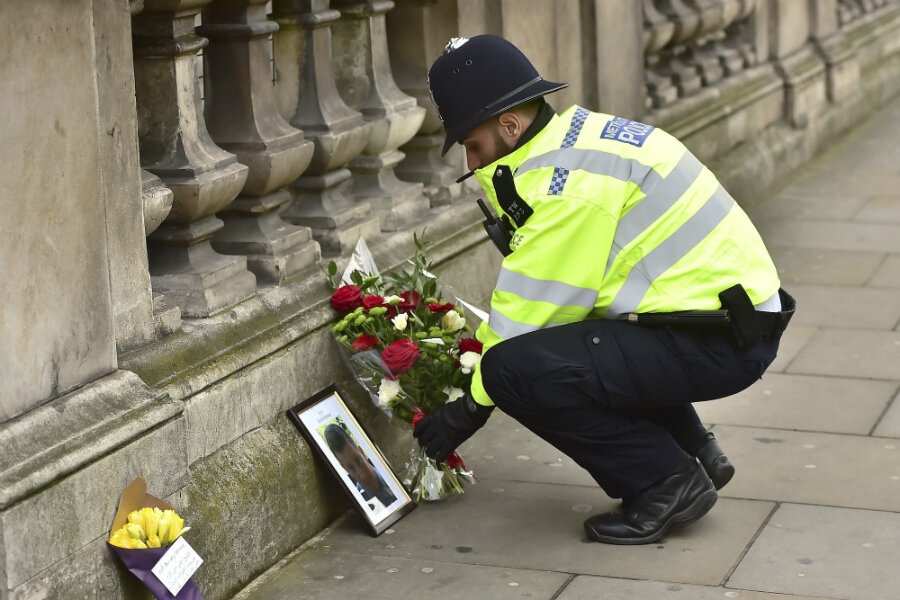In swift response to London terror attack, eight suspects arrested as Parliament resumes
Loading...
[Editor's note: This file was updated at 12:00 p.m. to include the name of the attacker.]
As Londoners seek to resume business as usual, a police investigation of Wednesday’s attack continues.
In the attack, a man driving an SUV plowed into a crowd of pedestrians on Westminster Bridge, killing two people and injuring approximately 30, police indicated. Many of those injured were tourists. The attacker then fatally stabbed a police officer on Parliament’s grounds before being shot by police.
Investigators have carried out at least six raids on addresses in London, Birmingham, and elsewhere, arresting eight suspects, as they work to establish the man’s motive, identify his associates, and determine to what extent the attack was premeditated. The attacker, police said, was British-born and known to MI5. In addition to the police officer and the attacker, who was shot by police, two people died on Westminster Bridge and at least 30 others were injured, seven critically.
British police have identified the person responsible for the terror attack near Parliament as Khalid Masood. Mr. Masood was born in southeastern England and was most recently living in central England. Police say Masood, who had been arrested previously for assault, possession of offensive weapons, and public order offenses, wasn't the subject of any current investigation, according to the Associated Press.
The Islamic State militant group (ISIS) has claimed responsibility for the attack, stating through its Aamaq News Agency that the attacker was an ISIS soldier who "carried out the operation in response to calls for targeting citizens of the coalition" of countries fighting ISIS in Syria and Iraq, according to the AP.
The nation’s chief counterterrorism officer called for calm amid the fear.
“We must not allow terrorists to sow discord and fear in our city,” said Mark Rowley, the assistant commissioner of the Metropolitan Police.
British Prime Minister Theresa May struck a similar tone in an address to the House of Commons on Thursday morning, saying Londoners and tourists would “all move forward together, never giving in to terror and never allowing the voices of hate and evil to drive us apart.”
"As I speak millions will be boarding trains and airplanes to travel to London, and to see for themselves the greatest city on Earth," she said. "It is in these actions – millions of acts of normality – that we find the best response to terrorism – a response that denies our enemies their victory, that refuses to let them win, that shows we will never give in."
London Mayor Sadiq Khan encouraged residents to participate in a candlelight vigil in Trafalgar Square on Thursday night. The vigil, he suggested, would signal Londoners’ unity and solidarity with those killed or injured.
The message of resilience seems to have resonated with Londoners, many of whom recall the IRA terrorist attacks in London and even the Blitz bombings during World War II.
"Brits are quite stoic. I think it's carrying on as normal, it's the style," Kate Cornish, who works for the Department of Education, told the Evening Standard. The Department of Education was put on lockdown yesterday during the attack.
"Nothing would have kept me at home today," Rus Odihiri, a policy adviser who works for the Department for Environment, Food and Rural Affairs, told the Evening Standard. "I could have worked from home but I was intent on coming in to work."
To some degree, events in Europe may have prepared locals for an attack, Michael Torrance, a House of Lords official, told The New York Times.
"Parliament is obviously an iconic British institution, everyone was concerned, knew it was a target. Everyone’s alive to that," he explained.
Parliament, which was locked down on Wednesday, returned to work on Thursday, observing a moment of silence for the victims at 9:33 a.m. local time in honor of the shoulder number, 933, of murdered officer Keith Palmer. Parliament Square, Westminster Bridge, and the surrounding area were behind a police cordon, which many observers found reassuring.
Behind the cordon, forensic investigators continue to look for clues at the site where the attack occurred. The investigation will also focus on the car driven by the assailant, which was registered in Essex, to the east of London, and may have been rented in Birmingham, The New York Times reported.
Public information may also help investigators. Last month, British security services launched a program, Action Counters Terrorism, to encourage ordinary people to share information about potential terrorism with police. Of the 13 attacks thwarted in the past four years, Mr. Rowley said then, most were prevented with the help of public information.
This report contains material from the Associated Press.






